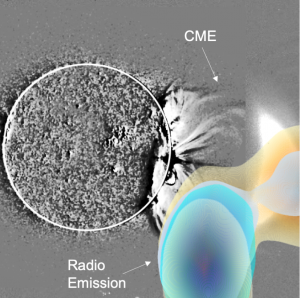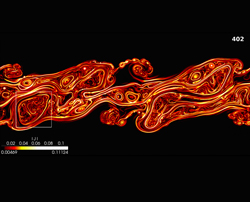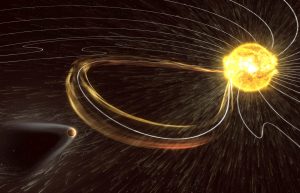Below are listed topics suitable for BSc and MSc theses. MSc theses are 30 credits and maximum length is about 80-100 pages. BSc thesis are 6 credits and maximum length is about 20 pages. The motivation of the BSc thesis is to familiarize writing scientific text and they can be literature reviews or contain a small research task. Our MSc theses contain typically a more extensive research task. Most of the topics below can be tailored to both purposes. Finnish speaking students write typically their BSc thesis in Finnish, while most of our MSc theses are written in English.
Page last updated: 12.01.2022
Identifying Moving Radio Sources Associated with Solar Storms Using Radio Observations and Modelling of Magnetic Fields
The Sun is an active star and the source of the most powerful explosions in the Solar System such as solar flares and solar storms. Solar storms can be accompanied by bursts of radiation at radio wavelengths that result from fast electrons produced during these eruptions. In some cases, moving radio sources are associated with solar storms. The aim of this project is to identify moving radio sources that originate from within solar storms to obtain estimates of their internal magnetic field strength. The project will use radio images of the Sun from international radio telescopes combined with ESA/NASA spacecraft data. The data analysis and modelling will be done in Python using software dedicated to the analysis of solar observations, Sunpy, but IDL may also be used. Experience with coding is desired, however, training will be provided to use the data analysis tools. In particular, applicants interested in writing their Msc thesis on this project are encouraged to apply. Contact: Diana Morosan (at) helsinki fi

Multi-wavelength analysis of solar eruption source regions
The nearest star to our planet, the Sun exhibits all sorts of small-scale eruptions and large-scale explosions in various wavelengths. The signatures of these emissions can be seen throughout the electromagnetic (EM) spectra. The most intense outbursts on the Sun are known as Coronal mass ejections (CMEs). CMEs are the signatures of huge amounts of plasma material released in interplanetary space along with the solar magnetic field. CMEs are the primary drivers of any interplanetary disturbances, and hence affects the space weather. CMEs are often accompanied with other wavelength eruptions/signatures e.g., as flares in x-ray, erupting waves in extreme ultraviolet (EUV), radio bursts in metric and decametric radio wavelengths. The aim of this project is to work on identifying the source region and the emission mechanism of these eruptions in radio wavelengths, and associated phenomena in other wavelengths. For this work, the data with multi space and ground based instruments will be used. The data analysis will be done using Python/MATLAB. A candidate with experience in Python/MATLAB is desired. Contact: Anshu Kumari (at) helsinki fi and Diana Morosan (at) helsinki fi
Quantifying wave power in near-Earth space during magnetic storms
Magnetic storms are periods of large disturbances in the Earth’s magnetic environment. They are characterised by a strong intensification of the ring current flowing around the Earth, quantified by the Dst or SYM-H geomagnetic indices which provide a proxy of the storm’s intensity. Magnetic storms are however also associated with intense wave activity which is not accounted for in these proxies, but can result in significant effects such as energetic particle acceleration and losses. In this project, we will use a global wave power index to identify the largest wave storms, and investigate how their intensity compares with other storm proxies. We will then identify which storm drivers result in these most intense wave storms. This project will make use of various spacecraft and ground-based observations in near-Earth space. The data analysis will be done using Python. This project is suitable for either a BSc or MSc thesis. Type: data analysis Contact: Lucile Turc (at) helsinki fi
Turbulence in coronal mass ejection plasmas
Turbulence, a universal phenomenon found in low-viscosity fluids, plays a fundamental role in transferring energy from large to small length scales in space plasmas. This energy transfer process has been extensively studied in the solar wind, but is much less well understood for coronal mass ejection (CME) plasma. CMEs are discrete eruptions of plasma from the Sun, in contrast to the more continuous outflow of the solar wind. In this project, you will investigate the properties of turbulence in CMEs and compare them with the turbulence properties of the solar wind. Cutting-edge data from the Parker Solar Probe and Solar Orbiter spacecraft, now approaching distances very close to the Sun, will be used. The project may involve (i) a mix of data analysis and theory or (ii) modelling and theory, depending on the interests of the successful applicant. The work performed would be suitable for either a BSc or MSc thesis, and funding is available for up to 3 months during summer 2022. Contact: Simon Good (at) helsinki fi

Real-time physics-based space weather forecasting using Euhforia
Solar eruptions and in particular coronal mass ejections (CMEs) are the main drivers of space weather, i.e., conditions in space that can have an adverse effect on the performance of space-borne as well as ground-based technological systems. With our society becoming increasingly more dependent on such technologies, answering the need for space weather prediction capabilities has risen to become a key topic in solar-terrestrial research efforts. UH is actively engaged in the development of a novel European space weather tool named EUHFORIA. The goal of this thesis work is to introduce the student to the physical modeling principles powering EUHFORIA, to run space weather forecasts as well as aid in the development of the tool. Tasks can include e.g. assessment of the accuracy of the space weather predictions, determination of error sources in the modeling pipeline or developing new components to the model, for instance implementation of magnetic flux-rope based models of coronal mass ejections. Type: simulations and data analysis Contact: Eleanna Asverstari (at) helsinki fi

Heliospheric shock Database and properties of interplanetary fast-mode shocks
Fast mode shocks are ubiquitous in the interplanetary space. In solar-terrestrial physics the role of fast shocks is of paramount importance as they accelerate charged particles to very high energies (several tens of MeV) and the turbulent post-shock flows may cause severe geomagnetic disturbances. In addition, the study of collisionless shocks is an important part of fundamental plasma physics. The Heliospheric Shock Database developed and maintained at the University of Helsinki is a comprehensive database of interplanetary shock database with user-friendly search and data download options. The thesis work is related to the development of the Heliospheric Shock Database , in particular related to its Machine Learning code and conducting an analysis of shock properties at different heliospheric distances and driven by different large-scale heliospheric structures. Type: code development and data analysis. Contact: Emilia Kilpua (at) helsinki fi

Influence of the interplanetary magnetic field strength on the properties of magnetosheath mirror modes
Mirror mode waves are plasma waves which are characterized by anti-correlated fluctuations of the magnetic field strength and plasma density. They develop in plasmas with large temperature anisotropies and are observed in many space environments, such as planetary magnetosheaths, the wake of comets and ICME sheaths. Here we will focus on mirror modes developing in the Earth’s magnetosheath. Understanding the properties of the magnetosheath is particularly important in the study of solar-terrestrial relations as this region is at the interface between the solar wind and the magnetosphere and regulates the energy and plasma transfer from the former to the latter. The aim of the project will be to compare the properties of the mirror modes in two simulation runs with almost identical set-ups, but with different interplanetary magnetic field strength, which allows to separate the effects of a change in this parameter. The runs have been performed with a global model called Vlasiator, which simulates the solar wind-magnetosphere interaction with unprecedented detail. The results will be compared with spacecraft observations. The project is directly contributing to a European Research Council grant, and a Marie Curie grant. Type: Modelling and data analysis Contact: Minna Palmroth (at) helsinki fi
Modelling solar eruptions from birth to lift-off
Coronal mass ejections are large-scale solar coronal structures that eventually violently erupt from the Sun. They are powered by magnetic energy that has accumulated in the corona over time spans of several days supplied by slowly evolving motions in the photosphere. These changes can be readily observed and used to determine the electric field that is responsible for generating the eruptive structures in the corona. In this project, a coronal time-dependent model using such electric fields will be used to study the formation of solar eruptions and their magnetic fields. Such modelling work can be used for improving the accuracy of space weather forecasting, essential for protecting modern technology. The project involves using Python-based simulation software, 3D data visualization and/or inversion methods of remote-sensing solar observations depending on the interest of the candidate. No knowledge of solar or plasma physics is required, but familiarity with the Python/NumPy/SciPy ecosystem is advantageous. The project can be targeted as a BSc or a MSc thesis topic. Type: Modelling and data analysis Contact: Daniel Price (at) helsinki fi
Energy transfer at the magnetopause
The magnetopause is an intriguing boundary that separates the Earth’s magnetic domain (called the magnetosphere) from the interplanetary space. All magnetospheric dynamics, like the vivid auroral displays, are driven by energy transferred from the solar wind. Energy transfer is hot topic in magnetospheric physics, but it is investigated globally only approximately. Vlasiator is the world’s most accurate space environmental simulation developed with two ERC grants. The target here is to utilise Vlasiator and to first develop a method for magnetopause detection. Knowledge of the boundary location will then be used to perform analysis of energy transfer at the magnetopause as a function of driving conditions. Type: Modelling and data analysis Contact: Minna Palmroth (at) helsinki fi
Electron precipitation and atmospheric chemistry during different solar wind drivers
Solar influence on climate is an active research area. Recent atmospheric models attempt to take into account energetic particle precipitation effects on the middle atmosphere. In particular, modeling the energetic electron precipitation (EEP) is a challenge. Most significant source of EEP is the Van Allen radiation belt. Wave-particle interactions scatter the electrons trapped originally in the Earth’s magnetic field into the atmosphere. EEP leads to the production of gases having important role in middle atmosphere ozone balance. It is known that radiation belts respond differently to different solar wind drivers (coronal mass ejection related plasma clouds, their turbulent sheath regions and slow-fast stream interaction regions). However, EEP and resulting atmospheric response have not yet been related to the type of the solar wind driver. Organizing the EEP and atmospheric response with the type of solar wind driver might help to understand better solar influence on regional climate. This MSc thesis is focused on analyzing EEP and atmospheric response (in particular ozone response) during coronal mass ejections and sheath regions. Contact: Emilia Kilpua (at) helsinki fi

Sheath regions driven by interplanetary coronal mass ejections
Interplanetary coronal mass ejections (ICMEs) are huge eruptions of plasma and magnetic flux originating from the Sun. ICMEs often propagate through interplanetary space so fast that a shock wave forms in front them. The plasma between the shock and the leading edge of an ICME is called the sheath region. ICME-driven sheath regions have particularly turbulent internal structures because of complex physical processes at the shock and the ICME leading edge, and they are remarkable drivers of geomagnetic activity. ICME-driven sheaths differ from planetary magnetosheaths due to the expansion they experience while propagating in interplanetary space. This BSc topic will focus on ICME sheaths, their general properties and the ways they differ from other sheath structures by reviewing literature. Both theoretical and practical approaches are possible. Also, the topic can include a small research task and extended to a MSc thesis. Contact: Emilia Kilpua (at) helsinki fi

Magnetic helicity in space plasma
Magnetic helicity is one of the key observables in solar and interplanetary studies. In particular, small-scale solar dynamo produces magnetic helicity and without removing it continuously from the Sun the large-scale dynamo would quench. In addition, it has been suggested that the reversal of the large-scale solar magnetic field every about 11 years is facilitated by huge magnetized plasma clouds, coronal mass ejections, removing helicity. This thesis will focus on presenting the concept of the magnetic helicity (different definitions) at the Sun and in interplanetary space and reviewing the key literature around this issue. For a MSc thesis this topic can be extended to include an analysis of the helicity of magnetic clouds in the solar wind. Contact: Emilia Kilpua (at) helsinki fi

Hamiltonian approach to wave-particle interactions of relativistic electrons.
The Earth’s radiation belts are the site of acceleration for electrons reaching velocities comparable to the speed of light. Generation of relativistic electrons constitute a threat to satellites and an open fundamental problem for a wide range of astrophysical plasmas. In this project we will use Hamiltonian theoretical tools and numerical tools to quantify the energisation of electrons. This project is suitable for a student of theoretical physics or applied mathematics with a background in analytical mechanics, electromagnetic and some basics coding experience. The tools we will use have a wide range of application across many fields of physics and can constitute a good springboard for a PhD. Contact: Adnane Osmane (at) helsinki fi
Flux Transfer Events and their interaction with Earth’s polar cusps
The solar wind carries magnetic field structures with a wide variety of field orientations towards Earth. In situations where the interplanetary magnetic field happens to be southward, it can cancel out part of the Earth’s dipole field. This process does not happen in a continuous manner, but in bursty phenomena called Flux Transfer Events (FTEs). Magnetic field lines on Earths’ dayside are are opened and reconfigured into plasmoids that carry magnetic field energy polewards. There, the plasmoids reconnect to the fieldlines coming out of the polar cusp structure, releasing some of their high energy plasma. The goal of this project is to understand and quantify the process of FTE-cusp interaction from global kinetic simulation data, and to compare to satellite and ground-based observations as well as theory. Type: simulation and data analysis Contact: Urs Ganse (at) helsinki fi
